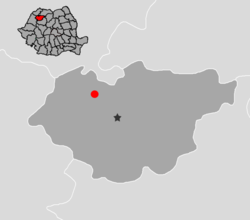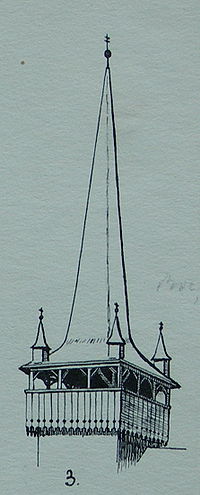
Bocşa, Sălaj
Encyclopedia


Transylvania
Transylvania is a historical region in the central part of Romania. Bounded on the east and south by the Carpathian mountain range, historical Transylvania extended in the west to the Apuseni Mountains; however, the term sometimes encompasses not only Transylvania proper, but also the historical...
, in Sălaj County
Salaj County
Sălaj is a county of Romania, in the historical regions of Crișana and Transylvania, with the capital city at Zalău.-Geography:Sălaj county has a total area of ....
, Romania. It is composed of four villages: Bocşa, Borla (Szilágyballa), Câmpia (Somlyómező) and Sălăjeni (Ököritó).
Tourism and sightseeing
In addition to the beautiful natural scenery, such as Dealul Măgurii, there are two buildings with historical value: the former building of the commune hall in Bocşa (1937–1938) and a house in Câmpia built in the 18th century.The former building of the commune hall in Bocşa became the Simion Bărnuţiu
Simion Barnutiu
Simion Bărnuţiu was a Transylvanian-born Romanian historian, academic, philosopher, jurist, and liberal politician. A leader of the 1848 revolutionary movement of Transylvanian Romanians, he represented its Eastern Rite Catholic wing...
memorial house in 1985. The memorial house is also a showcase of the history of Bocşa. In front of the museum is a bust of Bărnuţiu.
Another bust of Bărnuţiu (created by the artist Horea Flămându) was placed in the Central Park of Bocşa in 1967.
The brick church was consecrated in 1941. The remains of Bărnuţiu and those of a local Catholic clergyman, Alimpiu Barboloviciu
Alimpiu Barboloviciu
Alimpiu Barbuloviciu was the Vicar Forane of the Greek Catholic Vicariate of Şimleu Silvaniei and the head of the branch of Astra in Sălaj County.- Biography :...
, are placed in the church from Bocşa.
Geography
With a land area of 47.34 km2 (4000 ha), Bocşa is situated in the Zalău RiverZalau River
The Zalău River is a tributary of the Crasna River in Romania.- Hydronymy :There are several hypotheses which have been made regarding the origin of the river's name The Zalău River is a tributary of the Crasna River in Romania.- Hydronymy :There are several hypotheses which have been made...
Basin. The Zalău River flows through Bocşa. Bocşa village is situated at 18 km from Zalău
Zalau
Zalău is the seat of Sălaj County, Transylvania, Romania. In 2004, its estimated population was 62,900.- Ancient times :Zalău is situated in the area inhabited by "Free Dacians", 8 kilometers away from the historical landmark of Porolissum, a well-preserved Roman Castrum with an imposing fortress,...
city, and at 16 km from the projected Transylvania Motorway.
Demographics
According to the last census (2002), the total population of the commune counts 3463 inhabitants, of which 51.54% are RomaniansRomanians
The Romanians are an ethnic group native to Romania, who speak Romanian; they are the majority inhabitants of Romania....
, 39.79% Hungarians, 8.63% Roma and 0.04% are other nationalities.
Economy
The economy of the commune is primarily agricultural. It is known as an important wine producing area, with approx. 167 ha vine-lands. The wine of Borla is well-known even abroad.History
Bocşa was first mentioned in documents in 1349 under the name Villa Baxa. In 1854, its name became Olah-Baksa or Bocşa Română. Borla was first mentioned in 1341, Câmpia in 1427 and Sălăjeni 1430.After the conquest of the region by the Habsburgs, the inhabitants of Bocşa became, in majority, Greek Catholic. Communist government imposed a return to the Orthodox
Eastern Orthodox Church
The Orthodox Church, officially called the Orthodox Catholic Church and commonly referred to as the Eastern Orthodox Church, is the second largest Christian denomination in the world, with an estimated 300 million adherents mainly in the countries of Belarus, Bulgaria, Cyprus, Georgia, Greece,...
faith and a brick church replaced the ancient wooden church. At the end of the 1930s, the wooden church was transported to the Village Museum
Village Museum
The Village Museum is an open-air ethnographic museum located in the Herăstrău Park , showcasing traditional Romanian village life. The museum extends to over 100,000 m2, and contains 272 authentic peasant farms and houses from all over Romania.It was created in 1936 by Dimitrie Gusti, Victor Ion...
in Bucharest.
One famous Bocşa native is the great scholar Simion Bărnuţiu
Simion Barnutiu
Simion Bărnuţiu was a Transylvanian-born Romanian historian, academic, philosopher, jurist, and liberal politician. A leader of the 1848 revolutionary movement of Transylvanian Romanians, he represented its Eastern Rite Catholic wing...
, a historical figure and hero who fought for popular sovereignty in the 19th century. He was one of the leaders of the Transylvania
Transylvania
Transylvania is a historical region in the central part of Romania. Bounded on the east and south by the Carpathian mountain range, historical Transylvania extended in the west to the Apuseni Mountains; however, the term sometimes encompasses not only Transylvania proper, but also the historical...
n revolution in 1848–49. Simion Bărnuţiu
Simion Barnutiu
Simion Bărnuţiu was a Transylvanian-born Romanian historian, academic, philosopher, jurist, and liberal politician. A leader of the 1848 revolutionary movement of Transylvanian Romanians, he represented its Eastern Rite Catholic wing...
contributed to the development of the philosophic, politic and legal way of thinking of his people. He had lectures for pupils and students and some of his main works are still timely.
The settlements from Neolithic
Neolithic
The Neolithic Age, Era, or Period, or New Stone Age, was a period in the development of human technology, beginning about 9500 BC in some parts of the Middle East, and later in other parts of the world. It is traditionally considered as the last part of the Stone Age...
, Dacia
Dacia
In ancient geography, especially in Roman sources, Dacia was the land inhabited by the Dacians or Getae as they were known by the Greeks—the branch of the Thracians north of the Haemus range...
n state and the early Feudal period were found at the archeological site of Pietriş.
In the western part of Bocșa, toward Lompirt, on the Zalău River
Zalau River
The Zalău River is a tributary of the Crasna River in Romania.- Hydronymy :There are several hypotheses which have been made regarding the origin of the river's name The Zalău River is a tributary of the Crasna River in Romania.- Hydronymy :There are several hypotheses which have been made...
Valley, was found a prehistoric settlement and a pre-Feudal one.
Borla
The first written source about the village dates back to 1341 and refers to it under the name of Barla. Allegedly Barla is an allusion to ‘barlang’ (i.e. cave), where inhabitants used to retreat from waves of Tatar invasions. Excavations, however, revealed that the area was populated already in the Bronze Era, and some artifacts are even dated back to the Neolithic Era. The Szilágy-prefix was assigned when the train station was built in 1913, referring to the county.Around 1450 the village was the property of the Bishop of Várad (Oradea), who participated on the side of Hunyadi in the battle of Belgrade, and fell hostage to the Turks. Afterwards the village was owned mostly by the Bánffy family until the early 20th century.
Borla is inhabited mainly by Reformed ethnic Hungarians, although Baptists
Baptist Union of Romania
The Baptist Union of Romania is an alliance of Baptist churches for cooperative ministry in Romania. Since independent churches have no legal standing in Romania, the Baptist Union also provides a mediatorial relationship between churches and government.The first modern-era Baptists in Romania...
and Romanian Orthodox are present, as well as Roma and a few ethnic Romanians
Romanians
The Romanians are an ethnic group native to Romania, who speak Romanian; they are the majority inhabitants of Romania....
.
Local education has its roots in church-owned educational institutions, with written records as of 1852. The present school was built in 1970, mainly by local effort. The old school building is used as nursery school. Classes are held mainly in Hungarian, except for the Roma community, for which one aggregate class of the first elementary grades is maintained in Romanian. Afterwards pupils travel to the school in neighboring Bocşa.
Viticulture is the traditional occupation, with the soil allegedly more acidic than in other parts of the county (Sărmăşag
Sarmasag
Sărmăşag or Sarmaság is a commune in Sălaj County, Transylvania, Romania.-Geography and climate:The commune's altitude is low, between 160m and 379m. The climate is continental, the average temperature in January is -3 °C, in July 21.1 °C. The average annually precipitation is about 627mm. The...
and Şamşud
Samsud
Şamşud is a commune located in Sălaj County, Romania. It is composed of two villages, Şamşud and Valea Pomilor....
), which produces a more mature and full tasting wine than its local competitors.

